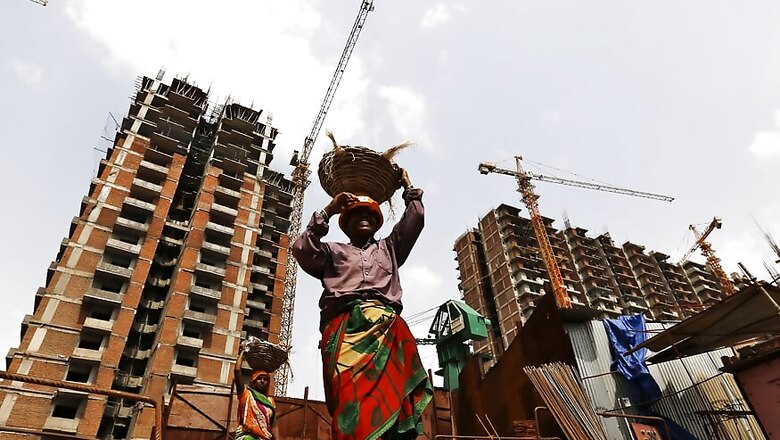
views
Is Indian economy on the verge of a recession?
While speculations are rife about extending the COVID-19 lockdown in India further into the month of June, quite expectedly ominous projections of GDP growth in 2020-21 have started coming in. According to latest CRISIL projections, the first quarter will “suffer a staggering 25% contraction,” and Indian economy is estimated to shrink 5% in 2020-21. Non-agriculture sector is estimated to plummet by 6.3%. Under a baseline scenario, the report estimates a 10% permanent loss to GDP (from the decadal trend level), which implies that a catch-up to the pre-crisis trend level of GDP will not be possible in the next three years, even if there is favourable policy support.
So, yes, India is staring at its fourth recession since Independence, first since liberalisation was initiated, and in all likelihood — the worst till date. The economy has already nosedived into that contractionary downturn while the nation is in lockdown.
Is India’s Atmanirbhar package adequately big fiscal stimulus to tackle the recession?
Announced with a headline grabbing figure of 20 lakh crore, India’s Atmanirbhar package does not have enough firepower to boost demand. That is quite evident from different estimates of the actual fiscal cost to the Central Exchequers, calculated by various banks, brokerages and rating agencies.
Actual fiscal cost, as percentage to GDP, ranges from 0.75% to 1.30% but nowhere close to the claimed 10% of GDP headline figure.
In any recessionary situation, money needs to be directly pump-primed into the system — mainly in the form of immediate investment. Boosting immediate economic activities by investing public capital enhances the purchasing power of the people in the economy, that purchasing power then is spent on consumption, that consumption boosts demand and instantly productions are augmented to meet that extra demand which creates more purchasing power in the economy. This cycle goes into the upper spiral and takes the economy out of recession. That is how investment multiplier works in any economy. Monetary interventions usually have very little immediate effect on the economy.
As the detailed break-up of the package and actual fiscal costs calculated by the State Bank of India (SBI) research publication (summary above) shows, making credit available and re-packaging existing government schemes are the focal points of this package. Even before the pandemic started the Government of India (GOI) has been trying to make credit available at cheaper interest rate, with the hope that potential investors and producers will borrow and new investments will follow in the aftermath. In the last couple of years, that strategy has fetched zero dividend.
In today’s monumental crisis time, the GOI did not deviate from that unsuccessful path. When the economy was in a slowdown before, now in a pause, and expected to severely contract, why would producers and investors inside that economy take loans? They would certainly if they can see clear signs of revival in terms of production figures. For that, pure fiscal stimulus is needed.
What could have been an effective fiscal stimulus?
Back in the month of April, former CEA Arvind Subramanian and John Hopkins University Professor Devesh Kapur have argued for a direct fiscal stimulus in the tune of ₹10 lakh crore, or 5% of GDP. This was later endorsed by the FICCI Director General, and the business newspaper Mint reiterated that proposition in their editorial. The ₹10 lakh crore figure of direct fiscal stimulus subsequently found approval from a host of economists and public policy makers.
The broad idea has been to spend around ₹4 lakh crore to immediately transfer cash and food to the sea of jobless struggling migrant workers. The rest ₹6 lakh crore could have been spent towards pumping in money in different sectors of the economy — not in the form of tax benefits or some other indirect methods, but directly spending money for kickstarting the brick and mortar economy. Initiating a nationwide drive to erect infrastructure facilities could have been a good start.
How to finance a real ₹10 lakh crore fiscal stimulus package?
If one assumes SBI fiscal cost estimate to GOI (Government of India) of around ₹2 lakh crore as the real approximation of announced stimulus, then ₹8 lakh crore more needs to be provisioned. After fiscal spending measures announced in March (actual cost estimated to be roughly ₹1 lakh crore), GOI revised its borrowing requirement to ₹12 lakh crore in early May from the budgeted ₹7.8 lakh crore.
It is further assumed that this increased borrowing requirement, mostly from the open market, would take care of the March stimulus of roughly ₹1 lakh crore. So, ₹1 lakh crore more from the existing May stimulus needs to be funded, along with the proposed additional ₹8 lakh crore.
To raise this ₹9 lakh crore additional money, two major methods can be undertaken. But, before that a look at the interest rate direction in major economies of the world may be helpful and indicative.
Except for Japan and EU (both of which lost interest rate manoeuvrability long back), all other economies have slashed their rates substantially amidst COVID-19 spread. For most of the developed countries and potential international debt markets, the rates are generally hovering near zero-rate.
Therefore, the GOI can make an attempt to tap these favourable debt markets; the NRIs can also be offered COVID-19 bonds at floating rates — with the assumption that rates will be at lower level for some time. Value of Rupee worsening in the foreign exchange market is indeed a risk, but it is a risk worth taking at this juncture.
Many large funds, institutional and high net worth individuals” into “many large funds, institutional and high net worth individual investors”. So, the sentence reads – “In domestic market, however, there is a larger possibility of mobilisation of finance because many large funds, institutional and high net worth individual investors may opt for an assured return (guaranteed by GOI) COVID-19 bond — even at a relatively lower rate of interest. Attempt to mobilise ₹2 trillion each in these three categories of overseas debt market and different COVID-19 bonds is a plausible option.
Rest ₹3 trillion can definitely be monetised — borrowed from the RBI at a fixed rate lower than the repo rate (ideally around 3.5%) with longer duration (at least 10-year period). Till 1997, government deficit used to be automatically monetised at a rate much lower than the market rate.
Now is the time to take a leaf out of that, albeit temporarily. If the economy has to be revived then a stimulus of this order is necessary. Abiding by so-called “deficit mania” and subsequent “international rating scare” may kill the economy and then a lower fiscal deficit would not be able to help anybody in the next calendar year.
The author is Senior Fellow with ORF's Economy and Growth Programme. His main areas of research include macroeconomics and public policy, with core research areas in monetary economics and the political economy of finance.














Comments
0 comment